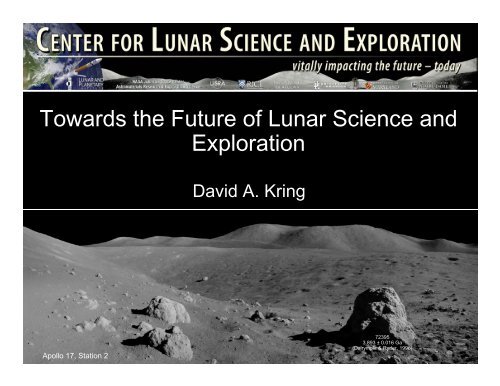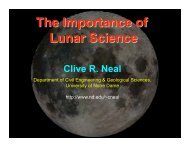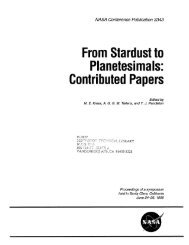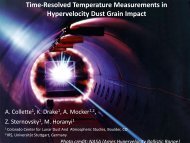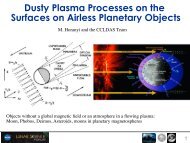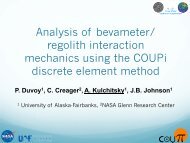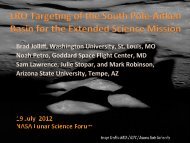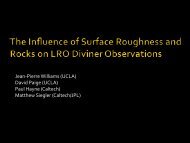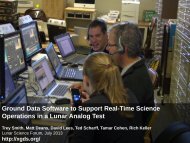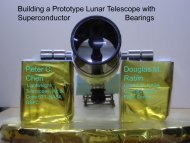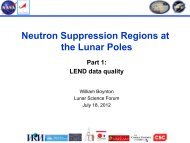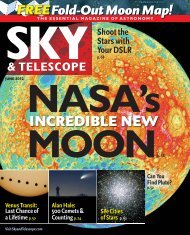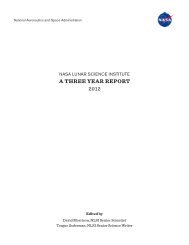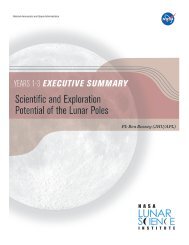Address the 1st and 2nd highest priorities of - NASA Lunar Science ...
Address the 1st and 2nd highest priorities of - NASA Lunar Science ...
Address the 1st and 2nd highest priorities of - NASA Lunar Science ...
Create successful ePaper yourself
Turn your PDF publications into a flip-book with our unique Google optimized e-Paper software.
Towards <strong>the</strong> Future <strong>of</strong> <strong>Lunar</strong> <strong>Science</strong> <strong>and</strong><br />
Exploration<br />
Apollo 17, Station 2<br />
David A. Kring<br />
72395<br />
3.893 ± 0.016 Ga<br />
(Dalrymple & Ryder, 1996)
<strong>Science</strong> concepts to be explored:<br />
1. The bombardment history <strong>of</strong> <strong>the</strong> inner solar<br />
system is uniquely revealed on <strong>the</strong> Moon<br />
2. The structure <strong>and</strong> composition <strong>of</strong> <strong>the</strong> lunar<br />
interior provide fundamental information on <strong>the</strong><br />
evolution <strong>of</strong> a differentiated body<br />
3. Key planetary processes are manifested in <strong>the</strong><br />
diversity <strong>of</strong> lunar crustal rocks<br />
4. The lunar poles are special environments that<br />
may bear witness to <strong>the</strong> volatile flux over <strong>the</strong><br />
latter part <strong>of</strong> solar system history<br />
5. <strong>Lunar</strong> volcanism provides a window into <strong>the</strong><br />
<strong>the</strong>rmal <strong>and</strong> compositional evolution <strong>of</strong> <strong>the</strong><br />
Moon<br />
6. The Moon is an accessible laboratory for<br />
studying <strong>the</strong> impact processes on planetary<br />
scales<br />
7. The Moon is a natural laboratory for regolith<br />
processes <strong>and</strong> wea<strong>the</strong>ring on anhydrous<br />
airless bodies<br />
8. Processes involved with <strong>the</strong> atmosphere <strong>and</strong><br />
dust environment <strong>of</strong> <strong>the</strong> Moon are accessible<br />
for scientific study while <strong>the</strong> environment<br />
remains in a pristine state
That framework gives us an opportunity to<br />
study some “big” ideas
Giant Impact Hypo<strong>the</strong>sis
<strong>Lunar</strong> Magma Ocean Hypo<strong>the</strong>sis
<strong>Lunar</strong> Cataclysm Hypo<strong>the</strong>sis
Debated: What was <strong>the</strong> magnitude <strong>and</strong> duration<br />
<strong>of</strong> <strong>the</strong> cataclysm?<br />
Consensus: Basin-forming epoch ended c. 3.8 Ga
Debated: What happened between 4.5 <strong>and</strong> c. 4.1 Ga?<br />
What was <strong>the</strong> source <strong>of</strong> <strong>the</strong> impactors?<br />
What were <strong>the</strong> effects <strong>of</strong> <strong>the</strong> basin-forming epoch?
Apollo 16<br />
Sample 60016,181<br />
Ancient regolith breccia<br />
that entrains visible<br />
(dark-colored) clasts <strong>of</strong><br />
impact melt.<br />
Also contains<br />
microscopic fragments<br />
<strong>of</strong> impactor relics
False-color element map <strong>of</strong> Apollo<br />
16 sample 60016.<br />
The image was made using<br />
innovative micro-analytical<br />
mapping technique to chemically<br />
fingerprint projectile fragments<br />
within lunar samples.<br />
The colors denote <strong>the</strong> distribution<br />
<strong>and</strong> concentration <strong>of</strong> different<br />
elements (white = aluminium, blue =<br />
silicon, green = magnesium, yellow =<br />
calcium, red = iron, pink = titanium,<br />
cyan = potassium). The field <strong>of</strong> view<br />
is ~7 × 9 mm.<br />
An UMMF (tiny green particle)
THE APOLLO 16 REGOLITH BRECCIAS<br />
• We calibrated <strong>the</strong> ages <strong>of</strong> regolith breccias <strong>and</strong> deduced we<br />
can use <strong>the</strong>m to evaluate <strong>the</strong> source <strong>of</strong> impactors during <strong>the</strong><br />
end <strong>of</strong> <strong>the</strong> basin-forming epoch <strong>and</strong> afterwards<br />
Joy et al. (GCA 2011)<br />
• Direct detection <strong>of</strong> impactors!<br />
Fragments preserved in regolith breccias as a function <strong>of</strong> time<br />
61135 (3.77 Ga)<br />
60016 (3.74 Ga)<br />
Joy et al. (<strong>Science</strong> 2012)<br />
60019 (3.35 Ga)<br />
60255 (1.70 Ga)
• Taking a closer look at <strong>the</strong> oldest cratered<br />
surfaces, new work by Marchi et al. (EPSL<br />
2012) suggests:<br />
• SPA preceded <strong>the</strong> cataclysm<br />
• That <strong>the</strong> impact velocities nearly doubled<br />
when <strong>the</strong> cataclysm occurred<br />
• Which is consistent with a dynamically<br />
evolving situation with <strong>the</strong> giant planets<br />
• In Strom et al. (2005), we developed a new tool<br />
for determining <strong>the</strong> source <strong>of</strong> <strong>the</strong> projectiles<br />
• The analysis indicated asteroids were <strong>the</strong> source<br />
• Indicated a size-independent sampling <strong>of</strong><br />
asteroids, implying migrating resonances, <strong>and</strong>,<br />
thus, that Jupiter’s orbit moved
Impact Melts from Minor Planet “H” in <strong>the</strong> Asteroid Belt<br />
Swindle et al. (2009)
Impact Melts from Minor Planet “LL” in <strong>the</strong> Asteroid Belt<br />
Swindle, Weirich, & Kring<br />
(to appear in 2012)
<strong>Lunar</strong><br />
Cataclysm<br />
Inner<br />
Solar System<br />
Cataclysm
Ancient Surfaces<br />
Before <strong>the</strong> <strong>Lunar</strong> Cataclysm<br />
Young<br />
Surfaces
Ancient Surfaces<br />
After <strong>the</strong> <strong>Lunar</strong> Cataclysm<br />
Young<br />
Surfaces
Message #1:<br />
This is not just a story about <strong>the</strong> Earth <strong>and</strong> Moon,<br />
but one that is providing fundamental insights about <strong>the</strong> accretion <strong>and</strong> orbital<br />
evolution <strong>of</strong> planetary bodies throughout <strong>the</strong> solar system.<br />
Number one science concept<br />
& <strong>highest</strong> science <strong>priorities</strong><br />
1. The bombardment history <strong>of</strong> <strong>the</strong> inner<br />
solar system is uniquely revealed on<br />
<strong>the</strong> Moon<br />
a. Test <strong>the</strong> cataclysm hypo<strong>the</strong>sis by<br />
determining <strong>the</strong> spacing in time<br />
<strong>of</strong> <strong>the</strong> creation <strong>of</strong> lunar basins<br />
b. Anchor <strong>the</strong> early Earth-Moon<br />
impact flux curve by determining<br />
<strong>the</strong> age <strong>of</strong> <strong>the</strong> oldest lunar basin<br />
(South Pole-Aitken Basin)<br />
c. Establish a precise absolute<br />
chronology (by measuring ages<br />
<strong>of</strong> representative craters<br />
throughout <strong>the</strong> Moon’s history)<br />
d. Assess <strong>the</strong> recent impact flux
Message #2:<br />
We have made more progress in <strong>the</strong> past 3 years <strong>of</strong> <strong>the</strong> NLSI<br />
than was made in <strong>the</strong> previous 30 years,<br />
but a lot <strong>of</strong> questions remain unanswered <strong>and</strong> require a return to <strong>the</strong> lunar surface.<br />
Number one science concept<br />
& <strong>highest</strong> science <strong>priorities</strong><br />
1. The bombardment history <strong>of</strong> <strong>the</strong> inner<br />
solar system is uniquely revealed on<br />
<strong>the</strong> Moon<br />
a. Test <strong>the</strong> cataclysm hypo<strong>the</strong>sis by<br />
determining <strong>the</strong> spacing in time<br />
<strong>of</strong> <strong>the</strong> creation <strong>of</strong> lunar basins<br />
b. Anchor <strong>the</strong> early Earth-Moon<br />
impact flux curve by determining<br />
<strong>the</strong> age <strong>of</strong> <strong>the</strong> oldest lunar basin<br />
(South Pole-Aitken Basin)<br />
c. Establish a precise absolute<br />
chronology (by measuring ages<br />
<strong>of</strong> representative craters<br />
throughout <strong>the</strong> Moon’s history)<br />
d. Assess <strong>the</strong> recent impact flux
Where to begin?<br />
The Earth-Moon System ~4 billion years ago
Schrödinger Basin<br />
w/i <strong>the</strong> South Pole-Aitken Basin<br />
<strong>Address</strong> <strong>the</strong> 1 st <strong>and</strong> 2 nd <strong>highest</strong> <strong>priorities</strong> <strong>of</strong><br />
NRC (2007) plus 14 o<strong>the</strong>r NRC (2007) goals<br />
SPA Image: LRO-LOLA/<strong>NASA</strong> GSFC SVS<br />
Schrödinger (320 km)<br />
L<strong>and</strong>ing Site Study<br />
O’Sullivan et al. (GSA Sp. Paper 2011)
Two teams <strong>of</strong> students are identifying l<strong>and</strong>ing sites where<br />
<strong>NASA</strong> <strong>and</strong> its international partners can address <strong>the</strong><br />
science objectives outlined in <strong>the</strong> National Research<br />
Council report The Scientific Context for Exploration <strong>of</strong> <strong>the</strong><br />
Moon. This novel summer program integrates science <strong>and</strong><br />
exploration on an exciting path that carries us beyond low-<br />
Earth orbit. The students represent several institutions:<br />
David Blair (Purdue University)<br />
Sarah Crites (University <strong>of</strong> Hawai'i)<br />
Myriam Lemelin (Université de Sherbrooke)<br />
Daniela Nowka (Freie Universität Berlin)<br />
Agata Przepiorka (Space Research Centre <strong>of</strong><br />
<strong>the</strong> Polish Academy <strong>of</strong> <strong>Science</strong>s)<br />
Stephanie Quintana (Colorado School <strong>of</strong> Mines)<br />
Carolyn Roberts (SUNY at Buffalo)<br />
Kirby Runyon (Temple University)<br />
Claudia Santiago (University <strong>of</strong> Texas-El Paso)<br />
Tiziana Trabucchi (University <strong>of</strong> New Brunswick)<br />
Program details: http://www.lpi.usra.edu/lunar_intern/<br />
For more information about <strong>the</strong> LPI-JSC Center for <strong>Lunar</strong><br />
<strong>Science</strong> <strong>and</strong> Exploration go to http://www.lpi.usra.edu/nlsi/<br />
Sponsored by <strong>the</strong> <strong>NASA</strong> <strong>Lunar</strong> <strong>Science</strong> Institute at<br />
http://lunarscience.arc.nasa.gov/<br />
NLSI<br />
A student<br />
studies an<br />
Apollo 16<br />
sample from an<br />
impact crater.<br />
Dr. David A. Kring speaks to <strong>the</strong> students about planetary surface<br />
exploration while <strong>the</strong>y study Apollo rocks in <strong>the</strong> <strong>Lunar</strong> Curatorial<br />
Facility at <strong>the</strong> <strong>NASA</strong> Johnson Space Center.<br />
40 students have received extensive (10 weeks) <strong>and</strong> intensive training thus far.
FIELD TRAINING & RESEARCH PROGRAM AT METEOR CRATER<br />
2010 Participants<br />
Jeffrey Balcerski (Case Western Reserve University)<br />
David Blair (Purdue University)<br />
Mat<strong>the</strong>w Chojnacki (University <strong>of</strong> Tennessee)<br />
Patrick Donohue (University <strong>of</strong> Notre Dame)<br />
Sarah Drummond (University <strong>of</strong> Tennessee-Knoxville)<br />
Joshua Garber (University <strong>of</strong> California-Davis)<br />
Michelle Hopkins (University <strong>of</strong> Colorado-Boulder)<br />
Mat<strong>the</strong>w Huber (University <strong>of</strong> Vienna)<br />
Steven Jaret (Harvard University)<br />
Anna Losiak (University <strong>of</strong> Vienna)<br />
Analisa Maier (University <strong>of</strong> Colorado)<br />
Julie Mitchell (University <strong>of</strong> Houston-Clear Lake)<br />
Lissa Ong (University <strong>of</strong> Arizona)<br />
Lillian Ostrach (Arizona State University)<br />
Katie O’Sullivan (University <strong>of</strong> Notre Dame)<br />
Ross Potter (Imperial College London)<br />
Stuart Robbins (University <strong>of</strong> Colorado-Boulder)<br />
Bhairavi Shankar (University <strong>of</strong> Western Ontario)<br />
Erin Shea (Massachusetts Institute <strong>of</strong> Technology)<br />
Kelsi Singer (Washington University)<br />
Michael Sori (Massachusetts Institute <strong>of</strong> Technology)<br />
Sebastian Sturm (Westfälische Wilhelms-Univ. Münster)<br />
Malte Willmes (Westfälische Wilhelms-Universität Münster)<br />
Michael Zanetti (Washington University)<br />
19 PhD c<strong>and</strong>idates<br />
5 MS c<strong>and</strong>idates<br />
Plus an additional 16 students in September 2011<br />
NLSI<br />
Nearly 60 graduate students have now<br />
been trained at Meteor Crater
INTEGRATED SCIENCE & EXPLORATION TRAINING: ASTRONAUTS<br />
Astronaut Stan Love describing<br />
<strong>the</strong> geology <strong>of</strong> Colton Crater to<br />
<strong>the</strong> <strong>Science</strong> Operations Center<br />
during a simulation <strong>of</strong> a 28-daylong<br />
mission to <strong>the</strong> Moon.<br />
• Work with astronauts <strong>and</strong> crew<br />
geologists to develop <strong>the</strong> protocols for<br />
planetary surface missions<br />
• Train new classes <strong>of</strong> astronauts<br />
about impact cratering processes <strong>and</strong><br />
impact-cratered planetary surfaces
Small Pressurized Rover (SPR) Concept<br />
<strong>Lunar</strong> Electric Rover<br />
<strong>Lunar</strong> Analogue Test Site<br />
San Francisco Volcanic Field, Nor<strong>the</strong>rn Arizona
D-RATS <strong>and</strong> LSS Tests at BPLF 2008
D-RATS <strong>and</strong> LSS Tests at BPLF 2008
D-RATS <strong>and</strong> LSS Tests at BPLF 2008
EXPLORATION – Desert RATS 2011 Mission Control Architecture<br />
Mission control center during <strong>the</strong> docking <strong>of</strong> space shuttle Atlantis with<br />
<strong>the</strong> ISS during its final mission (July 10, 2011)<br />
Mission Control<br />
During DRATS 2011:<br />
Flight operations <strong>and</strong><br />
science operations<br />
were conducted from<br />
<strong>the</strong> Mission Control<br />
Center<br />
Using <strong>the</strong> mission<br />
simulation room across<br />
<strong>the</strong> hall from <strong>the</strong> current<br />
SST <strong>and</strong> ISS flight<br />
control rooms
• If precursor mission funds re-appear, mature concepts exist.
Advanced concept robotic<br />
missions exist<br />
But were put on hold when<br />
LPRP canceled<br />
Is <strong>the</strong>re ano<strong>the</strong>r option?<br />
Earth-Moon L2 Mission:<br />
• L2 located 60,000 km<br />
above <strong>the</strong> lunar surface<br />
• Orion launched <strong>and</strong><br />
maneuvered into a halo<br />
orbit around L2
Lockheed Martin<br />
Burns, Kring, Norris, Hopkins, Lazio, & Kasper (2012)<br />
Exploration risk reduction:<br />
• Demonstrate Orion in<br />
deep space <strong>and</strong> high speed<br />
Earth-entry<br />
• 30 to 35 day mission into<br />
trans-lunar space as early<br />
as 2018<br />
• Crew will travel 15%<br />
far<strong>the</strong>r than Apollo <strong>and</strong><br />
spend 3 times longer in<br />
deep space<br />
• Practice tele-operation <strong>of</strong><br />
rovers
Lockheed Martin<br />
Burns, Kring, Norris, Hopkins, Lazio, & Kasper (2012)<br />
<strong>Science</strong> objectives:<br />
• L<strong>and</strong> <strong>and</strong> explore a region<br />
within SPA (i.e.,<br />
Schrödinger Basin)<br />
• Geologic measurements<br />
will be made.<br />
• A sample will be collected<br />
<strong>and</strong> returned to Earth.<br />
• An astrophysical system<br />
will be deployed.<br />
Status: Integrated science<br />
<strong>and</strong> engineering studies<br />
continue, while HEOMD<br />
reviews <strong>the</strong> concept.
Reaching for <strong>the</strong> Moon <strong>and</strong> Beyond<br />
Human space exploration is currently<br />
represented by <strong>the</strong> International Space<br />
Station (ISS) in low-Earth orbit. The<br />
location <strong>of</strong> <strong>the</strong> space station is <strong>of</strong>ten<br />
misunderstood, so it is illustrated with<br />
this graphic. The Earth <strong>and</strong> Moon in <strong>the</strong><br />
graphic were captured in <strong>NASA</strong> image<br />
PIA10244. The approximate altitude <strong>of</strong><br />
<strong>the</strong> ISS above <strong>the</strong> Earth’s surface is<br />
shown. This altitude varies from 173 to<br />
286 miles (278 to 460 km). The ISS is<br />
so close to Earth that it constantly<br />
looses altitude because <strong>of</strong> atmospheric<br />
drag. Engines on <strong>the</strong> ISS are<br />
episodically fired to repair <strong>the</strong> orbit. The<br />
ISS has flown for over 10 years,<br />
beginning in November 1998.
<strong>Lunar</strong> Mission Timeline (1976-2013)<br />
• The last lunar l<strong>and</strong>er was flown by <strong>the</strong> Soviet Union (Luna 24 in 1976)<br />
• The next lunar l<strong>and</strong>er is planned by China (Chang’e 3 in 2013)<br />
• There have been no <strong>NASA</strong> l<strong>and</strong>ers on <strong>the</strong> Moon in over 40 years<br />
It is time to get back on <strong>the</strong> lunar surface.
The Big Picture
The Big Picture – Moving <strong>the</strong> ball forward<br />
• Conduct l<strong>and</strong>ing site studies<br />
• Develop a new community <strong>of</strong> young investigators <strong>and</strong> explorers<br />
• Train astronauts in lunar surface analogue sites<br />
• Build hardware (e.g., <strong>the</strong> <strong>Lunar</strong> Electric Rover) for astronauts <strong>and</strong><br />
complementary robotic assets<br />
• Simulate missions to develop mission operational concepts <strong>and</strong> an integrated<br />
team <strong>of</strong> astronauts <strong>and</strong> support staff, including geologists<br />
• Communicate <strong>the</strong> rationale for <strong>the</strong>se activities to <strong>the</strong> public<br />
• And, at its core, develop <strong>and</strong> implement a world class science program that is<br />
integrated with exploration
The Moon is <strong>the</strong> best place in <strong>the</strong> Solar System to ….<br />
<strong>Address</strong> most <strong>of</strong> <strong>the</strong> scientific concepts outlined in <strong>the</strong> NRC (2007) report.<br />
For example, <strong>the</strong> Moon is <strong>the</strong> best place to<br />
test ideas about planetary differentiation & <strong>the</strong> formation <strong>of</strong> primitive crust<br />
Which has implications for all o<strong>the</strong>r inner solar system planets
The Moon is <strong>the</strong> best place in <strong>the</strong> Solar System to ….<br />
Test ideas about early impact bombardment & modification <strong>of</strong> <strong>the</strong> crust<br />
Which has implications for <strong>the</strong> surfaces all o<strong>the</strong>r inner solar system planets<br />
And implications for <strong>the</strong> accretion & orbital evolution <strong>of</strong> outer solar system planets<br />
So, given that <strong>the</strong>se extraordinary ideas can<br />
be explored within 3 days <strong>of</strong> Earth
Let’s Never Stop Exploring<br />
<strong>and</strong> get back to <strong>the</strong> lunar surface.
Cut live feed to protect copyrights<br />
Exit PowerPoint<br />
Play inspirational video


